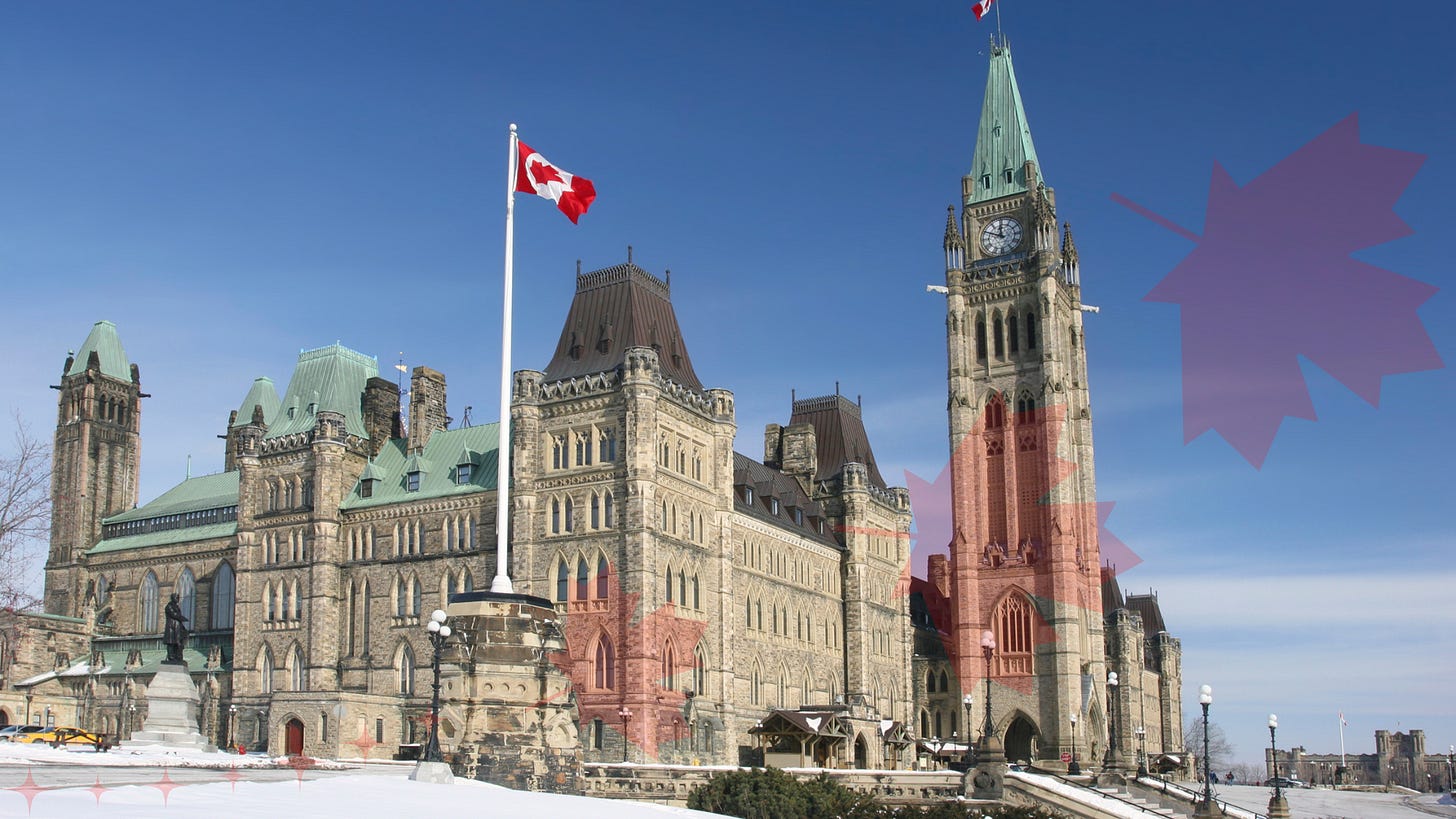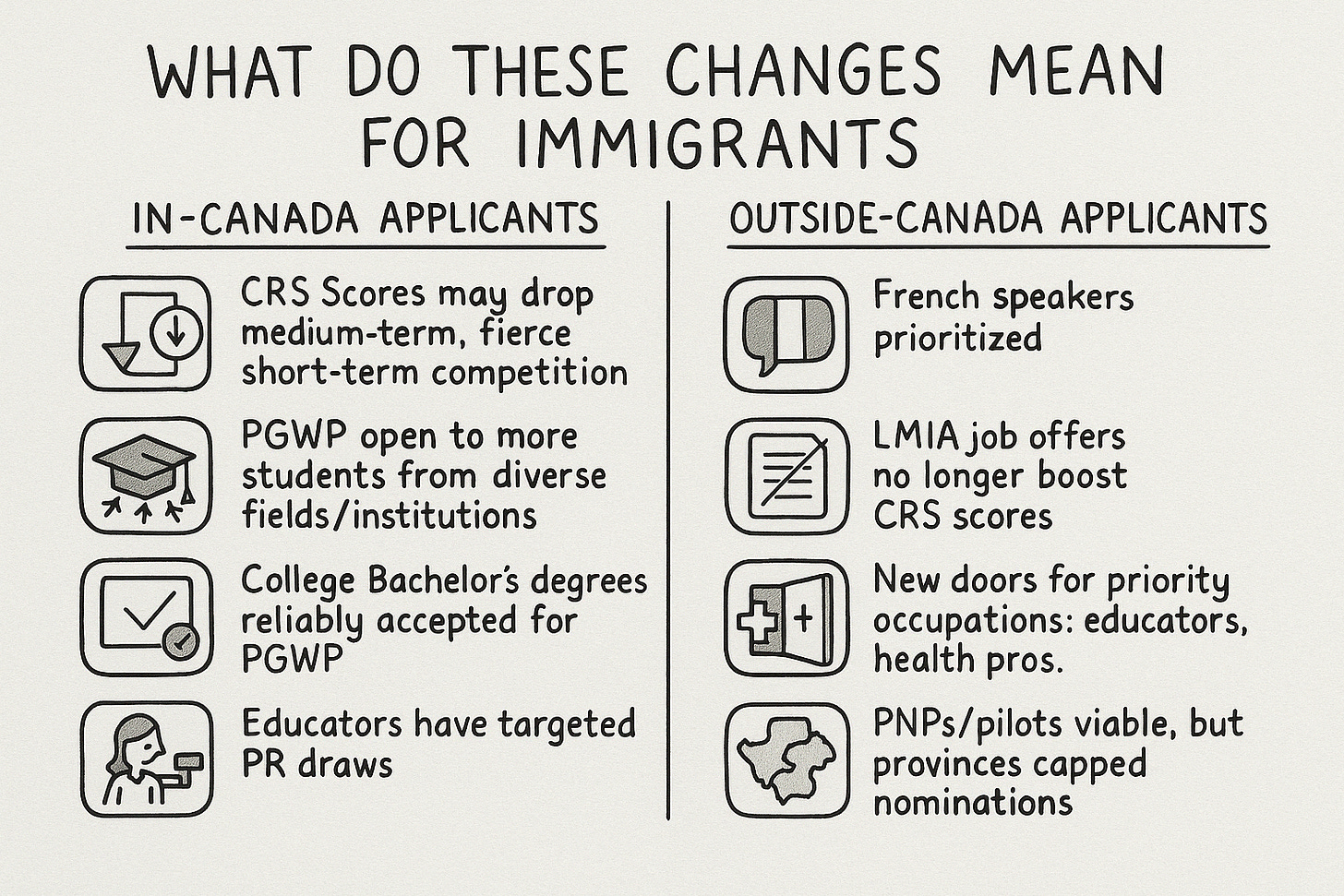Q1 2025 Canadian Immigration Updates
Q1 2025 has been relatively quiet compared to Q1 2024.
Please forward this to ONE friend today and tell them to subscribe here.2025 hasn’t exactly been the uppity we saw in 2024 for Canadian immigration. However, 90 days is a while, and a lot of the usual immigration pieces have changed or been shifted around. With a federal election coming in a few weeks, I wouldn’t be surprised if we see more changes in the coming months.
We may see shifts in PR targets, pilot programs, and regional priorities depending on the outcome.
Here’s What’s Changed in Canadian Immigration the Past 90 Days
LMIA points removed from Express Entry: On March 25, IRCC officially removed the 50 CRS points granted for arranged employment through LMIAs. This significantly affected CRS scores across the Express Entry pool and has redistributed thousands of profiles to lower bands.
Field of study no longer restricts PGWP eligibility: IRCC has confirmed that all eligible programs from Designated Learning Institutions (DLIs) now qualify for PGWPs — regardless of field of study. This expands access for students in career-oriented, niche, or non-traditional fields.
Bachelor’s degrees from colleges now more clearly PGWP-eligible: Post-secondary institutions offering bachelor’s programs — especially career colleges and polytechnics — now have clearer eligibility pathways for PGWPs, provided the institution is a DLI and the program meets length and academic standards.
Big changes to Express Entry: Category-specific draws have introduced 38 new occupations and removed 31, along with the addition of an entirely new category—Education. This is why I think the Express Entry system is the best immigration system in the world, if it is used to its fullest potential. You can find more details on the added and removed occupations at the end of this piece.
What Does This Mean for Immigrants?
In-Canada applicants
CRS scores may drop in the medium term, but in the short term, competition remains fierce.
PGWP eligibility is now broader, benefiting students from diverse fields and institutions.
College-level bachelor’s degrees are now more reliably supported in PGWP issuance.
Educators and early childhood teachers can now leverage targeted PR draws
Tech professionals may need to pivot strategies due to category exclusions.
Outside-Canada applicants
French-speaking applicants continue to benefit most from category-based selection.
LMIA job offers no longer boost CRS scores — a major shift for overseas workers.
Occupation-specific draws may open new doors, especially for priority roles like educators and health professionals.
Permanent residency through PNPs or pilots remains a viable route, but some provinces are operating under strict nomination caps.
P.S. At Immproved, we don’t just track policy. We build you an action plan around it.
Real-time Express Entry analysis
As of April 13th:
19,782 candidates had CRS scores between 501–600.
Even with biweekly draws of 3,000–4,000 ITAs, CRS may stay above 500 until at least June 2025.
Insights on CRS pool composition (Between March 16th and April 14th):
5,740 profiles dropped from the 501–600 range
1,618 profiles exited the 491–500 range
984 profiles dropped from the 481–490 range
2,157 new profiles appeared in the 461–470 band (likely due to loss of LMIA points)
The pool grew by over 7,000 candidates overall.
How Immproved Helps For Free
CRS and eligibility reassessments after LMIA point removal
Provide strategies on improving your CRS score and more- perfect of upcoming or recent graduates.
Guidance for tech applicants transitioning from STEM to alternative streams.
Tailored pathways for educators and ECEs navigating new PR options
Connect with immigration experts to help you develop a strategy to obtain your Canadian Permanent Residence!
Summary of Occupation Changes by Category
Healthcare and Social Services
Newly added occupations:
Animal health technologists and veterinary technicians – NOC 32104, TEER 2
Cardiology technologists and electrophysiological diagnostic technologists – NOC 32123, TEER 2
Dental hygienists and dental therapists – NOC 32111, TEER 2
Other medical technologists and technicians – NOC 32129, TEER 2
Pharmacists – NOC 31120, TEER 1
Pharmacy technicians – NOC 32124, TEER 2
Social and community service workers – NOC 42201, TEER 2
Social workers – NOC 41300, TEER 1
Removed occupations:
Educational counsellors – NOC 41320, TEER 1
Instructors of persons with disabilities – NOC 42203, TEER 2
Kinesiologists and other professional therapy occupations – NOC 31204, TEER 1
Other assisting occupations in health services – NOC 33109, TEER 3
Other practitioners of natural healing – NOC 32209, TEER 2
Traditional Chinese medicine practitioners and acupuncturists – NOC 32200, TEER 2
STEM (Science, Technology, Engineering, Math)
Newly added occupations:
Civil engineering technologists and technicians – NOC 22300, TEER 2
Electrical and electronics engineering technologists and technicians – NOC 22310, TEER 2
Geological engineers – NOC 21331, TEER 1
Mechanical engineering technologists and technicians – NOC 22301, TEER 2
Mechanical engineers – NOC 21301, TEER 1
Insurance agents and brokers – NOC 63100, TEER 3
Removed occupations:
Architects – NOC 21200, TEER 1
Business systems specialists – NOC 21221, TEER 1
Computer and info systems managers – NOC 20012, TEER 0
Computer engineers (excl. software) – NOC 21311, TEER 1
Computer systems developers and programmers – NOC 21230, TEER 1
Data scientists – NOC 21211, TEER 1
Database analysts/admins – NOC 21223, TEER 1
Engineering managers – NOC 20010, TEER 0
Info systems specialists – NOC 21222, TEER 1
Land surveyors – NOC 21203, TEER 1
Landscape architects – NOC 21201, TEER 1
Mathematicians/statisticians/actuaries – NOC 21210, TEER 1
Metallurgical/materials engineers – NOC 21322, TEER 1
Science policy researchers/consultants – NOC 41400, TEER 1
Software developers and programmers – NOC 21232, TEER 1
Software engineers/designers – NOC 21231, TEER 1
Urban and land use planners – NOC 21202, TEER 1
Web designers – NOC 21233, TEER 1
Web developers/programmers – NOC 21234, TEER 1
Trade Occupations
Newly added occupations:
Contractors/supervisors, oil & gas – NOC 82021, TEER 2
Floor covering installers – NOC 73113, TEER 3
Painters/decorators (excl. interior) – NOC 73112, TEER 3
Roofers/shinglers – NOC 73110, TEER 3
Concrete finishers – NOC 73100, TEER 3
Other technical trades – NOC 72999, TEER 2
Water well drillers – NOC 72501, TEER 2
Electrical mechanics – NOC 72422, TEER 2
Heavy-duty equipment mechanics – NOC 72401, TEER 2
Bricklayers – NOC 72320, TEER 2
Cabinetmakers – NOC 72311, TEER 2
Gas fitters – NOC 72302, TEER 2
Industrial electricians – NOC 72201, TEER 2
Sheet metal workers – NOC 72102, TEER 2
Machinists/tooling inspectors – NOC 72100, TEER 2
Home building/renovation managers – NOC 70011, TEER 0
Construction managers – NOC 70010, TEER 0
Cooks – NOC 63200, TEER 3
Construction estimators – NOC 22303, TEER 2
Removed occupations:
Residential/commercial installers – NOC 73200, TEER 3
Elevator mechanics – NOC 72406, TEER 2
Machine fitters – NOC 72405, TEER 2
Supervisors, misc. trades – NOC 72014, TEER 2
Agriculture and Agri-Food
Removed occupations:
Landscaping/grounds supervisors – NOC 82031, TEER 2
Agricultural service contractors/farm supervisors – NOC 82030, TEER 2
New: Education Category
Newly added occupations:
Elementary/secondary school teacher assistants – NOC 43100, TEER 3
Instructors of persons with disabilities – NOC 42203, TEER 2
Early childhood educators/assistants – NOC 42202, TEER 2
Elementary school and kindergarten teachers – NOC 41221, TEER 1
Secondary school teachers – NOC 41220, TEER 1







